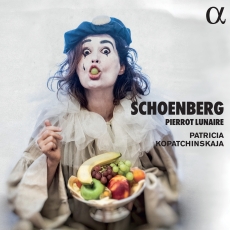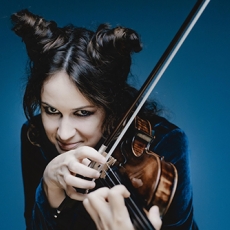Patricia Kopatchinskaja - Schoenberg: Pierrot lunaire - MusicWeb International
The ultimate Marmite performer meets the ultimate Marmite work? An awful lot about this recording will depend on reactions to Patricia Kopatchinskaja’s performance of the vocal part of the main work. People have been arguing about what constitutes sprechgesang since Schoenberg wrote Pierrot Lunaire in 1912. Those who find Pat Kop’s version over the top might be interested to hear Erika Stiedry-Wagner on a 1940 recording under the composer’s direction. Whilst this new recording is even more melodramatic, it isn’t that much more than on the earlier recording. Comparing both to Minton and Schäfer, both under Boulez, and we are very definitely hearing pretty conventional opera singing. Worse still, well though both sing, they are a little lifeless compared to Pat Kop’s occasionally almost deranged performance (in the best sense of course!)
There is a lot more to this performance than melodrama. Looking again at Schoenberg’s criteria for sprechgesang, Kopatchinskaja ticks every box. Pitched but not sung? Tick. Not conventional speech? Tick. One of the instruments of the ensemble rather than a soloist with accompaniment? Tick.
Two other elements of this account contribute to its success. Kopatchinskaja and her expert instrumentalists can scream and screech with the best of them but this is also the most purely beautiful Pierrot Lunaire I know. It is helped by yet another sumptuous recording from Alpha. Pierrot Lunaire can be a tough listen in some hands but this version tickled, stroked and battered my ears from first note to last.
As for the vocal performance, the words have seldom been delivered with so much vivid life and with such clarity. Every word can be understood even without the notes which are, in effect, a serious essay on the work, combined with texts and translations, all lavishly illustrated. Pat Kop mentions having contributed to many performances as a violinist and I think this shows in her recreation of the solo part. Even the most extraordinary passages, and there are some truly extraordinary passages, make musical sense as if she were treating her voice the way she treats bow and violin in her day job. Personally, I loved every second of it. Possibly for the same reasons, others will hate it. Try the third song Der Dandy. I doubt there will be many lukewarm reactions.
I understand the point of the Strauss and Kreisler in creating an ambience of pre-War Vienna but I doubt I will be returning to them much, well though they are played.
The four pieces for violin and piano, his Op 7, are Webern at his most concentrated. Written two years before Pierrot, they highlight the very different temperaments of the two composers, especially when set against Schoenberg’s Phantasy for Violin and Piano of 1949. In about 5 minutes, Webern covers virtually a whole concerto’s worth of music! By contrast, even in the expert hands of these performers – Joonas Ahonen on piano is marvellous throughout – I find the Schoenberg a piece that rambles somewhat and generally outstays its welcome. Their performance of the Webern will, I suspect, divide the crowd along similar lines to their Pierrot. Those who like their Webern cool and glacial beware! I enjoyed the intensity they bring to every gesture a lot. In such concentrated music, it is important that every note sounds like it matters.
The Schoenberg piano pieces Op 19 are much better known and are given a fine sensitive outing by Joonas Ahonen. They reflect Schoenberg exercising Webern-like brevity as he groped his way toward twelve tone music.
To end where I began, regardless of its many other merits, I suspect that the vocal performance of Pierrot will be the deciding factor with this CD. I expected to be irritated, but instead found myself entranced. So what if it is over the top? So was Schoenberg!

